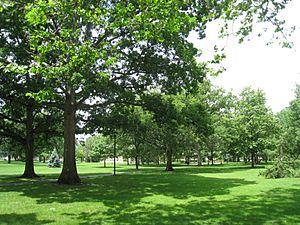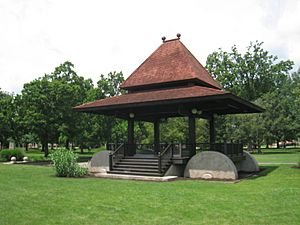Tappan Square facts for kids
Quick facts for kids Tappan Square |
|
|---|---|
 |
|
| Lua error in Module:Location_map at line 420: attempt to index field 'wikibase' (a nil value). | |
| Type | Urban park |
| Location | Oberlin, Ohio, United States |
| Area | 13.01 acres (5.26 ha) |
| Created | 1885 |
| Operated by | City of Oberlin, OH |
| Status | Open all year |
| Architect | Frederick Law Olmsted, Jr., John Charles Olmsted |
| NRHP reference No. | 66000615 |
| Designated NHL | 1965 |
Tappan Square is a public park in the center of Oberlin, Ohio. It is also a special place called a National Historic Landmark. The park first opened in 1885. It was created on 13 acres (about 5.3 hectares) of land owned by the city. This land was given by Charles Martin Hall, who supported Oberlin College.
Two famous designers, Frederick Law Olmsted, Jr. and John Charles Olmsted, planned the park. In the 1940s, the square was named after Arthur Tappan and Lewis Tappan. They were rich merchants from New York City. They helped Oberlin College when it was new. They were also strong abolitionists, meaning they worked to end slavery. Before this, the park was known as College Park or the Campus.
Until 1965, a very old tree called the Historic Elm stood there. People said that John Jay Shipherd and Philo Stewart prayed under this tree. They decided to start the town of Oberlin right there. For many years, college buildings were on the square. This included a five-story brick building called Tappan Hall. As these buildings got older, the area was cleared. It became a green space for everyone to enjoy. This was done because Charles Martin Hall wanted it that way in his will.
History of Tappan Square
The park's location was chosen by two ministers, John Jay Shipherd and Philo Stewart. They started their new community at the elm tree in the park's southeast corner. This historic elm tree stayed in the square until 1965. It had to be removed because of a disease.
One year later, Tappan Square was made a National Historic Landmark. The park is named after Arthur Tappan. He was an abolitionist from the 1800s. He gave money to the college when it was first starting. At first, the square was called "the Campus." Several college buildings were located there.
Later, Charles Martin Hall, who founded ALCOA and graduated in 1885, made a request. He wanted the buildings removed. He wanted the center of the campus to be a green space for both students and the community. Today, only two structures remain in the square. These are the Clark Bandstand and the Memorial Arch.
Tappan Square hosts many events for both the college and the town. Some common events include festivals, bonfires, and concerts. It also hosts the Oberlin Folk Fest and the Local Foods Festival. The square is home to the Oberlin Rocks. Students can paint on these rocks anytime. You might also see a small group of albino squirrels there. They are Oberlin's unofficial mascot! All events in Tappan Square are free. They help bring college students and Oberlin residents together.
The Memorial Arch
Oberlin College used to have a special department for theology students. These students became missionaries around the world. Many Oberlin-trained missionaries went to China's Shansi province. In 1899, many Oberlin missionaries were killed. This happened during the Boxer Rebellion, led by Chinese nationalists.
Recently, a plaque was added to the Arch. It honors the Chinese people who were also killed during that violence.
The Oberlin Rocks
There are two very large rocks in the south corners of Tappan Square. They were placed there in 1897 and 1933. The rock in the southwest corner has a plaque. It says the rock is a "Glacial boulder of granitoid gneiss." This means it's a large rock from eastern Canada. It was found 10 feet underground. Students from the class of 1898 placed it there.
The other rock is called the "Founders Boulder." It was found in Erie County. Its plaque says, "In Memory of John J. Shipherd, Philo P. Stewart." It was dedicated on June 17, 1933. However, you can't see either plaque anymore. Hundreds of layers of paint from students and town residents cover them. The rocks started being painted in the 1960s. Even college officials joined in this tradition. Today, anyone can paint these rocks at any time!


